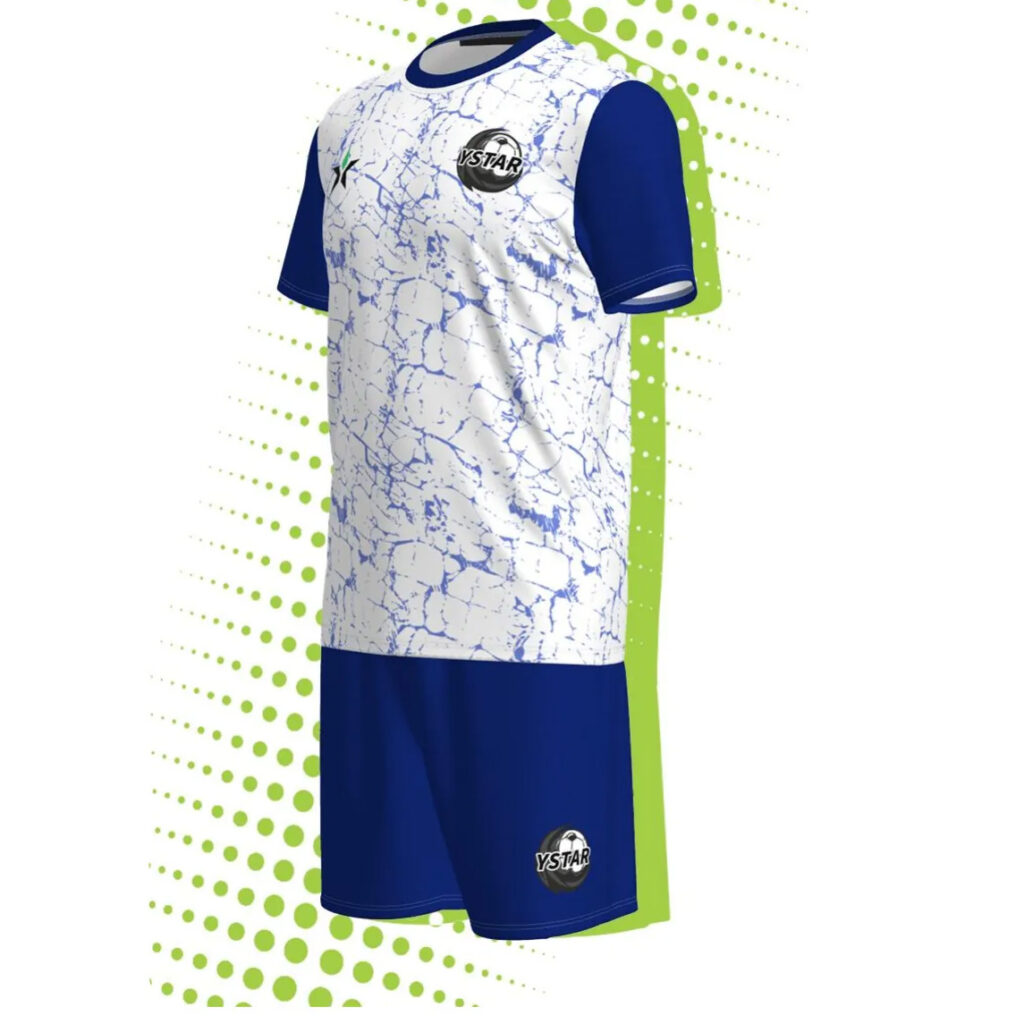The fabric used for サッカーユニフォーム can greatly affect not only players’ performance but also the whole experience during a game. No matter the weather or game intensity, the best Soccer Uniforms are made to keep athletes comfortable, agile and covered. The most often used textiles in football uniforms will be discussed in this post along with its features, 利点, and relative performance versus other materials available.

Soccer Uniforms Characteristics That Count
The performance of the athletes depends much on the fabric of football uniforms. Several important qualities should define a good football uniform fabric: 通気 性, moisture-wicking capacity, 耐久性, と柔軟性. Modern fabrics might also have cutting-edge technologies to improve the comfort and lifetime of the garment including UV protection, 防臭, and antibacterial qualities.
Since football is a high-intensity sport and players need materials that let air flow, so keeping the body cool and dry. Breathability is therefore quite important. Polyester mixes and other moisture-wicking fabrics help athletes stay dry even during the most demanding events by drawing sweat away from the skin. Another important consideration is durability since football uniforms are used extensively, washed often and even subjected to field abrasions. To let players have complete range of motion during gameplay, flexibility and stretch are absolutely vital.
ポリエステル: The Standard for Industry
Football uniforms feature polyester the most often used fabric. Polyester is a synthetic fabric well-known for its durability and moisture-wicking properties; it draws moisture away from the body and lets it evaporate fast, so keeping players dry. Polyester’s capacity to hold shape and fight wrinkles is among its most important advantages. These characteristics make it a preferred material for high-performance soccer uniforms.
Polyester is also a relatively affordable fabric compared to other options, making it a popular choice for both professional and recreational soccer teams. さらに, polyester blends can provide a soft feel, and it is highly resistant to fading, ensuring that the vibrant colors of soccer uniforms remain intact for long periods.
ナイロン: Strength and Durability
Nylon is another popular choice for soccer uniforms due to its exceptional strength and resistance to abrasion. Known for its smooth texture, nylon offers an excellent combination of comfort and durability. This fabric is also quick-drying, making it ideal for players who need to stay dry throughout the game.
One of the key benefits of nylon is its resistance to stretching and sagging, meaning soccer uniforms made from this material will retain their shape even after repeated use. Although nylon is less breathable than polyester, it is sometimes combined with other materials to produce a balanced, useful material for high-performance gear.
スパンデックス: Enhancing Flexibility
スパンデックス, often mixed with polyester or nylon, is used in soccer uniforms to provide excellent stretch and flexibility. Spandex allows for a snug fit that moves with the player’s body, enhancing comfort and agility. This fabric is particularly useful in the design of soccer uniforms that need to stay tight against the skin without restricting movement.
For players who require optimal freedom of movement, especially in positions where agility is critical, spandex is a must-have. It is often used in compression gear and other performance-enhancing wear that complements the main uniform.
Mesh Fabric: Maximizing Ventilation
Mesh is a lightweight, breathable fabric that is commonly used in the panels of soccer uniforms. The open weave design of mesh allows for maximum airflow, keeping players cool during intense matches. This fabric is especially useful for soccer uniforms worn in warmer climates or during the summer season when heat management is crucial.
While mesh fabrics are not as durable as solid polyester or nylon, they are often used in areas of the uniform that require increased ventilation, such as the underarms, sides, or back.
Recycled Fabrics: Eco-Friendly Options for Soccer Uniforms
Sustainability is an increasing concern in the sportswear industry, and many manufacturers are turning to recycled fabrics for soccer uniforms. These fabrics are made from recycled plastic bottles or other waste materials, helping reduce the environmental footprint of the garment. In addition to their eco-friendly properties, recycled fabrics often maintain the same high performance characteristics as virgin polyester, such as moisture-wicking and durability.
Recycled materials can be just as effective at keeping athletes cool and comfortable, with the added bonus of contributing to a more sustainable future.
Bamboo Fabric: Natural Comfort and Breathability
Bamboo fabric is gaining popularity in the sportswear market for its natural antibacterial and moisture-wicking properties. This eco-friendly fabric is incredibly soft to the touch, making it a comfortable choice for soccer uniforms. Bamboo is also known for being highly breathable, which helps regulate body temperature during intense physical activity.
While bamboo fabric is not as common as synthetic materials like polyester or nylon, its natural properties make it an excellent alternative for players looking for sustainable and skin-friendly options. Bamboo also has a lower environmental impact compared to traditional cotton.
マイクロファイバー: Lightweight and Highly Durable
Microfiber fabrics are incredibly lightweight and durable, making them a great option for soccer uniforms that need to withstand wear and tear. The fine fibers of microfiber provide a smooth, comfortable feel, while the material’s durability ensures that soccer uniforms will stand up to frequent use and washing.
Microfiber also excels in moisture-wicking performance, making it an ideal fabric for keeping athletes dry and comfortable. Its ability to maintain its shape and resist damage from abrasion makes microfiber a top contender for performance wear in soccer.
CoolMax: High-Performance Fabric for Intense Matches
For players who participate in high-intensity games, CoolMax is a fabric that offers superior moisture management and breathability. This fabric is engineered to keep athletes cool by moving moisture away from the skin and allowing it to evaporate quickly, reducing the risk of overheating during demanding physical exertion.
Although it is more commonly used in athletic wear for other sports, CoolMax is finding its way into soccer uniforms due to its cooling effect, which is ideal for long matches or training sessions under the sun.
Comparing Soccer Uniform Fabrics: Choosing the Best for Your Team
When choosing the best fabric for soccer uniforms, it’s important to consider the specific needs of your team. Do you need maximum breathability for hot weather, or is durability more of a priority for your players? Understanding the features of different fabrics and how they align with your team’s goals can help ensure that you select the best materials for performance, 快適, そして長寿.
While polyester remains the dominant choice due to its versatility and affordability, options like bamboo, ナイロン, and recycled fabrics are gaining traction for their eco-friendly qualities. 結局のところ, the best fabric for your soccer uniforms depends on factors like climate, activity level, and team preferences.

Selecting the right fabric for サッカーユニフォーム is essential for ensuring comfort, 耐久性, そしてパフォーマンス. With a variety of materials available—ranging from synthetic fibers like polyester and nylon to natural fabrics like bamboo—teams can make informed decisions based on their unique needs. Whether you’re outfitting a professional team or recreational players, understanding the benefits of different fabrics will help you make the best choice for your soccer uniforms.
When it comes to performance, 快適, そして耐久性, choosing the right fabric for soccer uniforms is critical. Incorporating the right blend of materials can make a noticeable difference in the player experience, allowing for greater focus and better overall results on the field.



